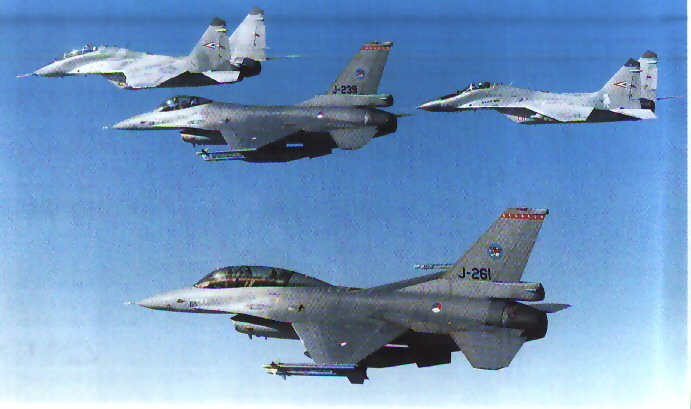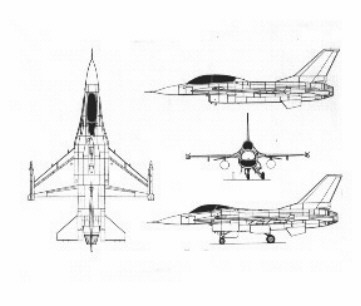<h2>General Dynamics F-16 Fighting Falcon</h2>


The F-16 had it's origin in the US Air Force's Lightweight Fighter (LWF) programme in 1972.
The first of two YF-16 prototypes made its official first flight on 2 February 1974. A level speed of Mach 2 at 12,200 m (40,000 ft) was reached on 11 March of the same year. The second YF-16 flew on 9 May 1974. During subsequent weapon trials, this aircraft extended the planned operational capability of the design by completing successfully the initial launch of Sparrow missiles on 6 October 1977.
On 13 January 1975 the Secretary of the US Air Force announced that the F-16 had been selected for full-scale development. The official YF-16 requirement for an air superiority day fighter was expanded to give equal emphasis to the air-to-surface role.
On 7 June 1975 a joint announcement by the four NATO countries of Belgium, Denmark, The Netherlands and Norway. An order for 348 aircraft (Belgium 116, Denmark 58, The Netherlands 102 and Norway 72.) Under co-production agreements, final assembly lines for these aircraft had been established in Belgium and The Netherlands (Fokker Aircraft Services). The Royal Netherlands Air Force ordered another 111 aircraft, so increasing the order to 223. They received the first one on 6 June 1979 to replace the aging F-104's the Dutch Airforce had in service then. In August 1977 Israel ordered 75 F-16 and in 1982 the Egyptian Air Force also received 40 aircraft.
Type
Single-seat lightweight air combat fighter (F-16A) and two-seat fighter/trainer (F-16B)
Other types
- F-16C. Updated version of the F-16A
- F-16D. Updated version of the F-16B
- F-16N. US Navy supersonic adversary aircraft. Modified from F-16C/D
- F-16XL. Leased by NASA, modified prototypes.
- F-16ES. Enhanced Strategic two-seat, long range interdictor, developed November 1993.
- F-16X. Projected development for 2010 service entry. 1.42 m fuselage stretch, modified F-22 delta wing, 80% additional fuel and improved engines.
Power Plant
One Pratt&Whitney F100-PW-200 turbofan engine.
Accommodation
Pilot only in F-16A. The F-16B has two cockpits arranged in tandem and both are equipped with all controls, displays, instruments and avionics.
Armament
General Electric M61A-1 20 mm multibarrel cannon with 500 rounds of ammo. Mounting for infrared air-to-air missile on each wingtip, one under fuselage hard point and six under wing hardpoints. The under fuselage hard point can be used for a load of up to 1,000 kg (2,200 lbs)
A typical load can include two wingtip mounted AIM-9 J/L/M Sidewinders, with up to four more on under wing stations; a 1,136 litre (300 US gallon) drop tank or a 2,200 lbs bomb under the under fuselage station; a Pave laser tracker pod, single or cluster bombs, air-to-surface missiles or flare pods on the four inner under wing hard points.
Dimensions
Wing span: 9.45 m (31 ft)
Length overall: 14.52 m(47 ft, 8 inch)
Height overall: 5.01 m (16 ft, 5.2 inch)
Weights
Weight empty: 6,866 kg (15,137 lbs)
Internal fuel load: 3,162 kg (6,972 lbs)
F-16A/B with typical load: 16,057 kg (35,400 lbs)
Performance
Max. level speed at 12,200 m (40,000 ft): above Mach 2.0
Ceiling: more than 15,420 m (50,000 ft)
Action radius: more than 500 nm (925 km, 575 miles)
Notes for ATFG pilots
The F-16 is your default fighter/attack aircraft. It is fast, agile and can take a fine load. In real life, F-16's have destroyed more aircraft than any other plane in history. If you can't choose which plane to fly a mission with, take the F-16. It's good at almost everything.
Back to the Plane Index.